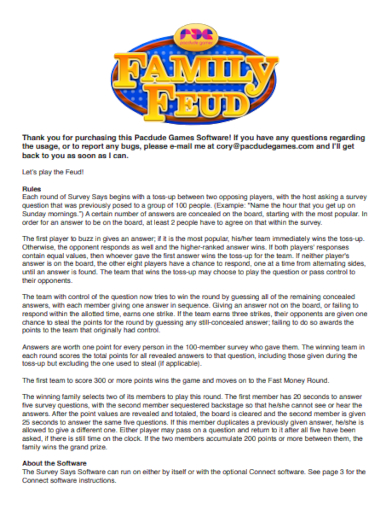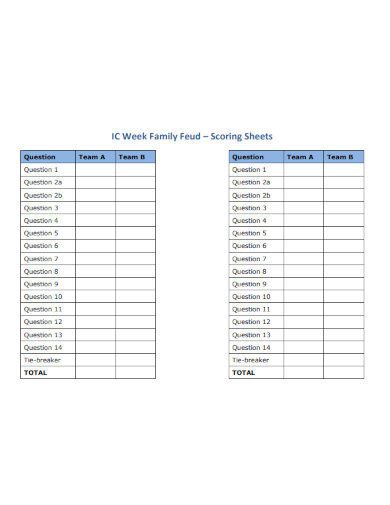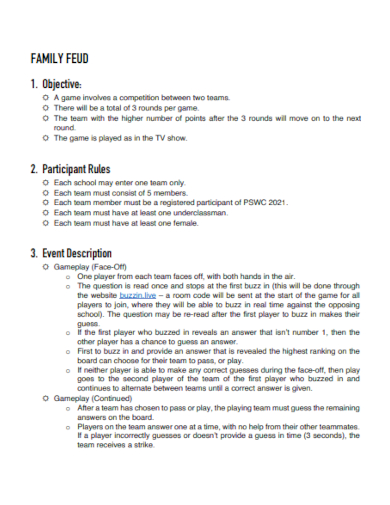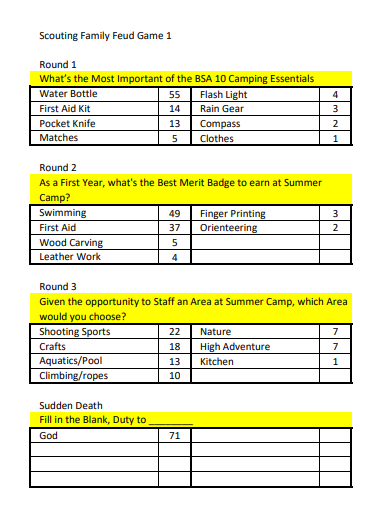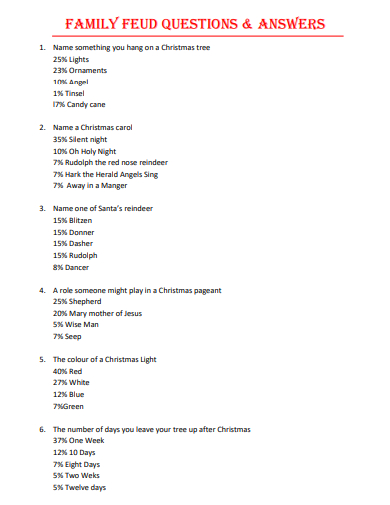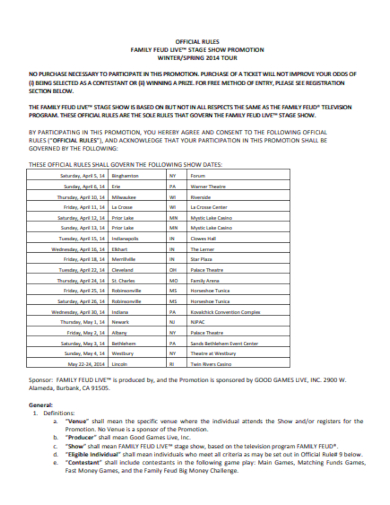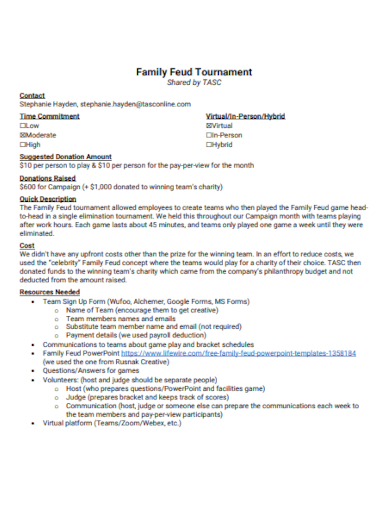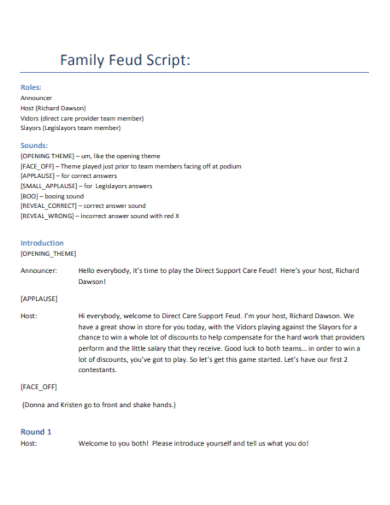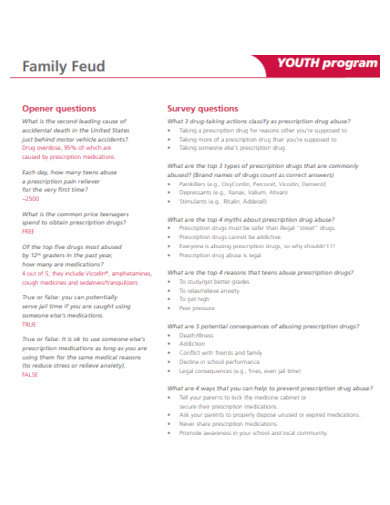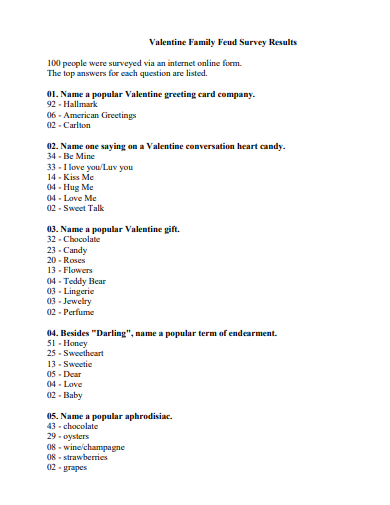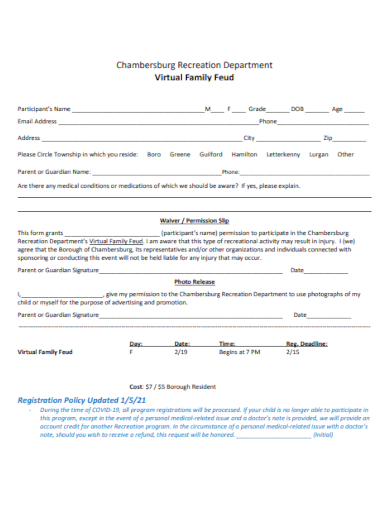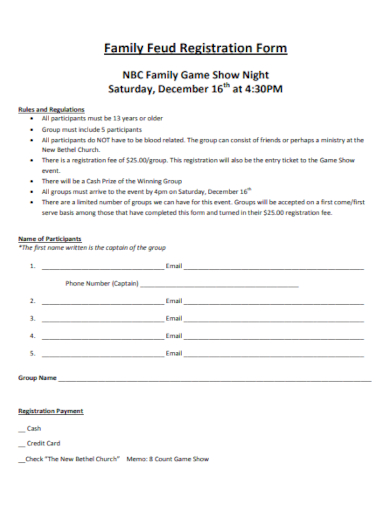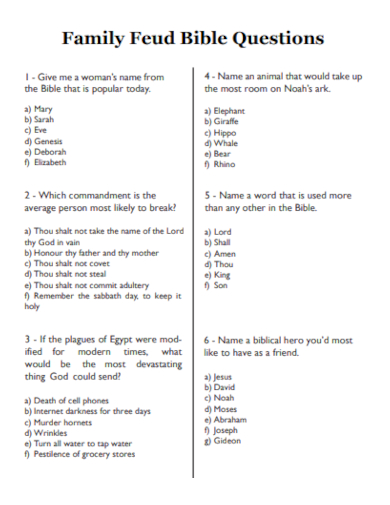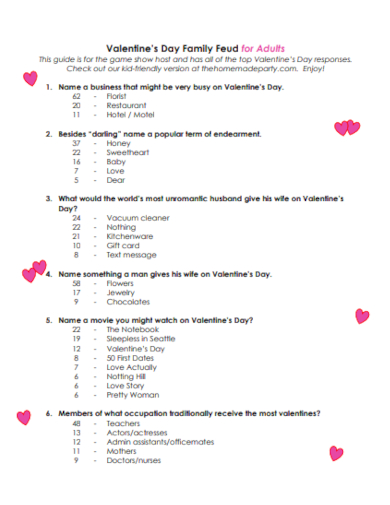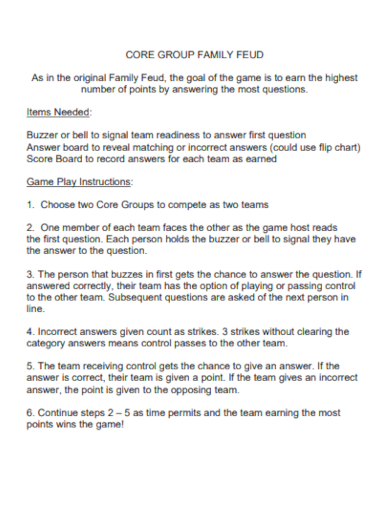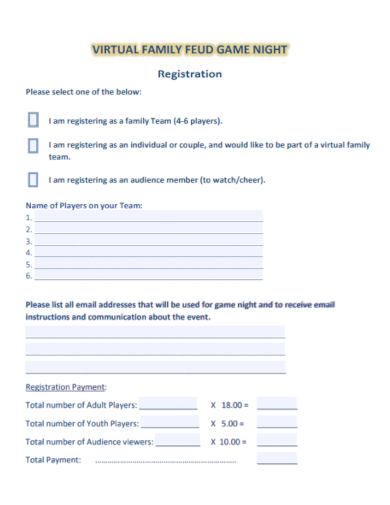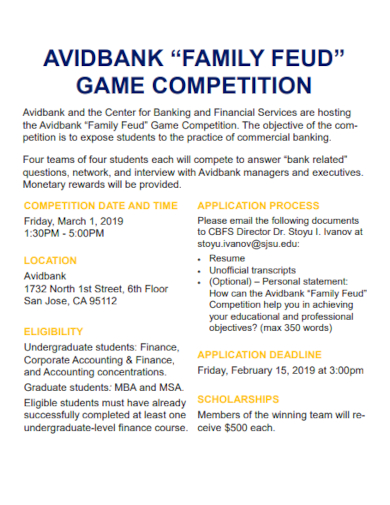Discover the ultimate way to amp up your family game nights with our Sample Family Feud Template! Designed to bring laughter, competition, and unforgettable memories, this template is your ticket to hosting your very own customized Family Feud showdown. Packed with user-friendly features and adaptable for any family size or theme, it’s the perfect addition to any gathering. Dive into a world where your family’s quirks become the highlight. Ready to reignite family fun? Start with our template today!
20+ Family Feud Samples
1. Family Feud Game Template
2. Family Feud Score Board
3. Family Feud Template
4. Blank Family Feud Template
5. Family Feud Questions and Answers
Family Feud: A Game of Wits, Laughter, and Family Dynamics
Family Feud is an iconic television game show that has resonated with viewers since its inception in 1976. Created by Mark Goodson, the show pits two families against each other as they compete to provide the most popular answers to survey questions posed to the general public. Over the years, this game has become a staple of American culture, bringing together the suspense of competition with the relatable dynamics of family interaction.
The show’s format is relatively simple, yet endlessly entertaining. Each family, typically composed of five members, takes turns guessing the most popular answers to a given question. These questions can range from the straightforward, like “Name a fruit you might eat in the morning”, to the more quirky, such as “What’s something you shouldn’t do at a traffic light?”. The answers, ranked by popularity, are displayed on a big board. Players score points based on how popular their answers are, with the most common answer granting the most points.
One of the key elements that sets Family Feud apart from other game shows is the family dynamic. Players often confer with their family members, leading to moments of humor, disagreement, and surprise. These interactions, along with the often-unexpected answers from contestants, add a layer of genuine unpredictability and relatability to the show.
Different rounds in the game have different stakes, culminating in the “Fast Money” round. Here, two members of the winning family have a chance to win significant cash prizes by quickly answering a series of questions, aiming to accumulate a set number of points.
Over the decades, Family Feud has seen several hosts bringing their unique charm to the show, from Richard Dawson, Ray Combs, and Steve Harvey, to name a few. Each has left an indelible mark on the show, contributing to its legacy.
Beyond the US, the format of Family Feud has traveled worldwide, with many countries adopting their own versions tailored to their culture and audiences.
In the digital age, Family Feud has also found its way into online games, apps, and board games, allowing fans to recreate the experience in their living rooms. Whether watched on TV or played at home, the appeal of Family Feud lies in its universal theme: the joys, quirks, and challenges of family life, all wrapped up in a game of wits and laughter.
6. Original Family Feud Template
7. Printable Family Feud
8. Family Feud Host Script
9. Family Feud Survey Questions
10. Family Feud Party Template
11. Sample Family Feud Invitation
12. Classroom Work Family Feud
13. Valentine Family Feud Survey Results
How to Play Family Feud: A Comprehensive Guide
Family Feud is a classic game show that has captured the hearts of audiences for decades. Its unique blend of general knowledge, sample strategy, and family dynamics offers endless entertainment. But you don’t need to be on TV to enjoy this game; it can be played in the comfort of your home, during gatherings, parties, or family reunions. Here’s a step-by-step guide on how to play Family Feud.
Setup:
Teams: Divide players into two teams, ideally representing two families. Each team should have an equal number of players, but if you’re playing informally, it doesn’t need to be exact.
Question and Answer Board: You can use a chalkboard, whiteboard, or even paper to list down the questions and answers. For a more authentic feel, there are also Family Feud board games available.
Prepare Questions: You’ll need a list of questions with multiple answers. Each answer should have a point value based on its popularity (like in the show, where answers are taken from surveys). There are many online resources, including apps, that have ready-to-use Family Feud questions.
Gameplay:
Face-Off Round: To start, one member from each team approaches the host for the initial question. The host reads the question, and the first player to signal (raise hand, buzz, etc.) gets the first chance to answer. The aim is to guess the most popular answer.
Main Round: If the first player to answer during the face-off doesn’t give the top answer, the other player gets a chance. The team with the higher-ranking answer then decides if they want to play the round or pass it to the other team. The playing team then continues guessing answers, one by one.
Strikes: If a player gives an answer that’s not on the board, the team gets a strike. Three strikes, and the opposing team gets a chance to provide one answer. If their answer is on the board, they steal the points accumulated in that round. If not, the playing team gets the points.
Scoring: Points are awarded based on the number of people who gave that answer in the survey. For example, if the top answer was said by 50 people, it’s worth 50 points.
Continue Rounds: Play as many rounds as you like. Typically, each player gets a chance to answer at least once.
Fast Money Round:
This is the bonus round for the winning team after the main rounds.
Two players from the winning team are selected. One plays first, while the second is kept isolated.
The first player is given five questions and has a limited time (usually 20 seconds) to answer them.
Points are tallied based on how many survey respondents gave the same answers.
The second player then answers the same questions, trying not to duplicate any answers. They get a little more time (usually 25 seconds).
If the combined scores of both players reach a certain threshold (typically 200 points), the team wins the grand prize or a set bonus.
Playing Family Feud is a delightful blend of wit, strategy, and quick thinking. It’s a great way to engage with family and friends, test your general knowledge, and enjoy some healthy competition. Whether you stick to traditional rules or add your own twists, the essence of the game remains a celebration of family, fun, and collective knowledge.
14. Virtual Family Feud
15. Editable Family Feud
16. Family Feud for Kids
17. Family Feud Bible Questions
18. Valentine’s Day Family Feud
19. Sample Group Family Feud
20. Virtual Family Feud Game
21. Family Feud Game Competition
Creating a Family Feud Template: A Comprehensive Guide
If you’ve ever tuned into the popular game show, Family Feud, you know the excitement and suspense it brings to viewers. However, you don’t have to be a television producer to bring that same energy to your next gathering or event. Creating your own Family Feud template is both fun and straightforward.
Begin by choosing your platform. While traditional methods like paper and pen are easy and always accessible, digital platforms such as Microsoft PowerPoint offer more interaction and engagement. For those looking to take the game online, tools like Kahoot or QuizUp provide a more modern touch.
Design is crucial. Your template should closely resemble the Family Feud game board with a distinct section for the question and separate boxes for each potential answer. These boxes will be revealed as participants guess the answers.
Gathering compelling and intriguing questions is the heart of the game. You can look online, in board games, or even create a personalized touch by sending out surveys to friends and family using tools like Google Forms or SurveyMonkey. This way, you’re using real answers from people you know, making the game even more relatable.
Once you have your questions, it’s time to input the answers. Rank each answer based on its popularity from the survey responses. The most common answer will be your top choice, with subsequent answers descending in order.
If you’re opting for a digital format, interactivity is essential. Use animations or actions to reveal answers when clicked. To add suspense, consider integrating timers for each round of questioning.
A scoring system will help keep the game competitive. If you’re keeping things simple, designate someone to keep track of points manually. However, many digital platforms automatically manage the scoring for you.
The aesthetic of your template plays a significant role in capturing the essence of Family Feud. Embrace bold colors, clear fonts, and add retro graphics for a classic game show feel. Icons like buzzers and the iconic “X” for wrong answers can elevate the game’s authenticity.
Finally, always test your template before game night. Run through the entire game to ensure questions and answers appear as they should. It’s also beneficial to ask someone else to play a mock round, giving you a chance to gather feedback and make necessary adjustments.
In conclusion, creating a Family Feud template is an enriching experience that promises hours of entertainment. With your customized template, you’ll be all set for a thrilling game night that showcases wit, knowledge, and family or friend dynamics.
Related Posts
Sample Business Card Templates
Sample Cashier Job Descriptions
Questionnaire Samples
FREE 10+ Sample HR Resource Templates in PDF
FREE 10+ HR Consulting Business Plan Samples in MS Word | Google Docs | Pages | PDF
FREE 49+ Sample Job Descriptions in PDF | MS Word
FREE 16+ Nonprofit Budget Samples in PDF | MS Word | Excel | Google Docs | Google Sheets | Numbers | Pages
FREE 13+ Academic Calendar Templates in Google Docs | MS Word | Pages | PDF
FREE 10+ How to Create an Executive Summary Samples in Google Docs | MS Word | Pages | PDF
FREE 23+ Sample Event Calendar Templates in PDF | MS Word | Google Docs | Apple Pages
Company Profile Samples
FREE 10+ Leadership Report Samples [ Development, Training, Camp ]
FREE 24+ Sample Payment Schedules in PDF | MS Word
FREE 10+ Return to Work Action Plan Samples in PDF | DOC
Autobiography Samples & Templates

